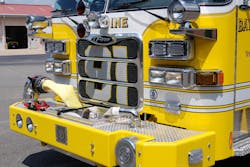Apparatus Architects: Front Bumper Protection, Then & Now
Early custom-cab apparatus were equipped with chrome-plated steel bumpers that afforded little protection for the cab or the crew. Front bumper extensions were limited to about 16 inches, which provided room for front-suction piping and a center-mounted hosewell.
Beginning around the late 1960s, several progressive departments began to specify a 1.5-inch front discharge equipped with 100 feet of hose for use in extinguishing car and dumpster fires. Heavy-rescue trucks were built with front-mounted winches and small toolboxes that would have to be reinforced to provide sufficient strength to the bumper assembly.
By this point, several apparatus builders migrated to using stainless-steel bumpers that were more durable but still provided little protection for the cab, as they were bolted to the front frame extensions with little support on the sides where the bumper would radius back to the cab. When involved in an intersection accident, the bumper would bend inward, damaging the siren and whatever components were mounted on the deck in addition to collapsing into the front of the cab, resulting in extensive damage.
Current design
Current apparatus design enables multiple hose wells, tool compartments, electric and hydraulic hose reels along with bumper-mounted extrication tools. Bumper extensions are commonly 20–24 inches with larger ones designed to accommodate rescue tools. Depending upon what the department desires to have located on the bumper extension, there can be upwards of $20,000 worth of equipment mounted in this area. Beyond protecting the bumper-mounted components, the front bumper should be designed to protect the crew and prevent intrusion into the cab seating area.
Apparatus specifications should detail a reinforced steel bumper to protect the crew and front of the apparatus in the event of an accident. The specification verbiage would read like this example: “The front bumper extension shall be constructed of 80,000-psi, high-tensile steel channel a minimum of 10 inches high x 3 inches wide x 0.25 inches thick. The bumper shall be backed full width with a quarter-inch-thick steel reinforcement channel supported on each side outboard of the main chassis frame rails. The bumper design shall be bolted with grade 8 hardware and angled on each end. The bumper shall be painted job color red with the top flange of the bumper protected with black color Linex material. The bumper assembly shall be a minimum of 18 inches and a maximum of 22 inches from the front face of the cab. The final design of the front bumper assembly shall be reviewed and approved by the fire department at the pre-construction conference.”
In sum
Apparatus has evolved over the years; however, the bumper and forward portion of the cab continue to be some of the most valuable areas to consider when designing the front bumper layout to meet the operational needs of the department.

Tom Shand
TOM SHAND, who is a Firehouse contributing editor, is a 36-year veteran of the fire service. He works with Michael Wilbur at Emergency Vehicle Response, consulting on a variety of fire apparatus and fire department master-planning issues. Shand is a member of the Firehouse Hall of Fame.

Michael Wilbur
MICHAEL WILBUR, who is a Firehouse contributing editor, retired as a lieutenant in FDNY, where he was last assigned to Ladder Company 27 in the Bronx. He has served on FDNY's Apparatus Purchasing Committee and consults on a variety of apparatus-related issues around the country. Wilbur is a member of the Firehouse Hall of Fame. For further information, access his website at www.emergencyvehicleresponse.com.






